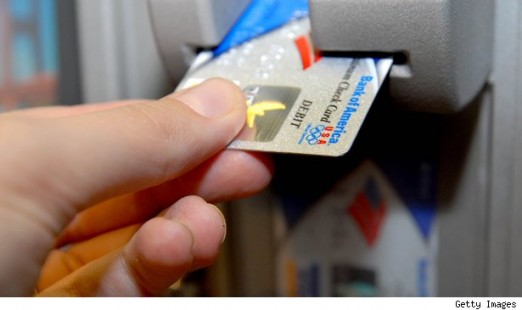Why Your Credit Card Needs an International Upgrade: The EMV Chip

Аndrew Cross was in Paris back in 2009, taking classes at Negocia Business School, when he ran into a problem that plagues many American travelers.
“At the train station on my way to catch a flight at Charles de Gaulle Airport, I tried to buy my ticket with my American Visa card, which was declined because of the magnetic strip,” said Cross, who now lives in Chicago. “The kiosk didn’t take cash, so I had to convince the man behind me in line to buy my ticket with his card, and I paid him in cash. I barely caught my shuttle to the airport.”
What tripped up Cross is that U.S. credit cards lack a key feature that’s standard in nearly all of Western Europe, and many parts of Asia: an embedded “EMV” credit card chip.
The EMV — which stands for EuroPay, MasterCard and Visa — is a microprocessor that encrypts and stores the account information. And in Europe, many automated ticket dispensers and kiosks can only read those chips — not the magnetic stripe alone that’s so common on American-issued cards.
But U.S. travelers may not have to suffer too much longer. Bank of America (BAC) announced late last month that it is rolling out EMV chip technology on many of its consumer credit cards.
Falling Behind Because We Were Already Ahead
EMV cards, which were first introduced in 1994 in the U.K. and Japan, are now the standard throughout Europe, says Stephanie Ericksen, head of authentication product integration at Visa.
In those days, Europe’s Internet infrastructure was less robust, and it was too expensive for bank issuers to authenticate transactions from a merchant’s point-of-sale device through online networks. The EMV chip, with its dynamic cryptography, solved the problem, allowing banks a safe way to approve transactions off-line.
The U.S., by contrast, had a strong online infrastructure, and thus, no need to adopt EMV technology. As a result, it has been slow to catch on here: In 2011, out of a total of 234.1 million Visa cards in the U.S., just 1 million were EMV chip-equipped, according to a . In Western Europe, 94.4% of cards are EMV-equipped, according to EMVco. Worldwide there are approximately 1.5 billion EMV cards and 21.9 million POS terminals that accept EMV cards.
Catching Up Now
“Our rollout of chip-enabled credit cards is focused on those customers who tend to travel overseas,” said Betty Riess, spokeswoman for Bank of America. “That’s why we are automatically adding the chip to those card programs where we see customers traveling internationally.” Among those: Merrill Lynch credit cards, U.S. Trust Accolades, BankAmericard Travel Rewards, BankAmericard Privileges and Virgin Atlantic credit cards.
In addition, the chips will be an option that cardholders can request for credit card programs like AAA Members Rewards, BankAmericard Cash Rewards and the Royal Caribbean card.
“The new chip-enabled cards will improve convenience and security of customers’ transactions when traveling abroad,” said Consumer and Small Business Products Executive Susan Faulkner.
“If you think about the evolution of payments, we’ve come a long way in 45 years, from paper cards to embossed cards to the current magnetic stripe cards,” said Carolyn Balfany, group head of product delivery in U.S. markets at MasterCard. “Every step in this evolution has been deliberate to make the consumer, issuer and merchant experience better.”
Security Concerns
EMV technology also makes credit card counterfeiting more difficult, which is why some argue the U.S. has been too slow to adopt it.
The reason may be that the EU’s privacy laws and regulations are stricter and more advanced than those in the U.S. according to Ramsés Gallego, international vice president of the Information Systems Audit and Control Association.
“As an example, there is a new and more aggressive legislation in the works in the EU regarding privacy and what data can be transferred,” he said. “Data saved on the magnetic stripe can be more easily counterfeited. With the chip, the data are embedded and better protected. The wide adoption of the chips in Europe is largely the result of a different risk posture in Europe.”
Countries that don’t adopt the chips are putting consumers at risk, according to Jeremy King, European Director of the PCI Security Standards Council.
“What is clear is that EMV chip cards have been effective in cutting down fraud in face-to-face transaction,” he said. “And as the world migrates to EMV, fraud pressures mount on those countries that have not adopted it.”
Of course, EMV chips aren’t without flaws.
“There is no such thing as 100% security, so there is still the possibility that they can be hacked, but it is much more difficult,” Gallego said. “The chips help prevent cards from being hacked in large volumes, quantities. At the current moment, it is the best method for embedding personal data within a card.”
Now an account executive at Walker Sands Communications in Chicago, Cross reflected on his frustration at not having an EMV-equipped card while in Paris: It wasn’t so much the annoyance that got to him, but rather the sheer vulnerability that non-EMV card carriers face.
“You do hear reports of credit card fraud related to the magnetic strip from time to time,” he said, “so it will be interesting to see if the U.S. credit card companies move to make EMV technology mainstream.”
Comments close